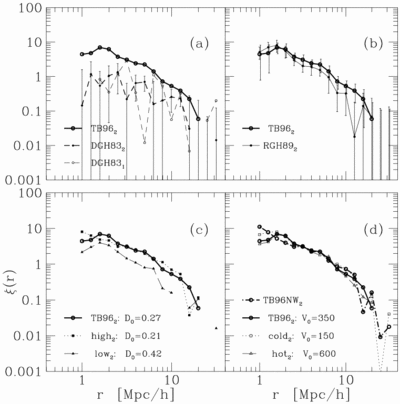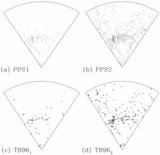Image Details

Caption: Fig. 4.
Comparison of ξGG(r) in PPS2 for the loose group sample TB962 and other samples identified as in previous analyses. (a) As in JZ88/GH83 (D0 = 0.52, V0 = 600; here we adopt φ(L) as in RGH89), for both PPS1 and PPS2. (b) As in RGH90/RGH89 (D0 = 0.27, V0 = 350; φ(L) as in RGH89), for PPS2. (The parameters of TB962 are D0 = 0.27, V0 = 350, and φ(L) as in TB96a, TB96b.) The high noise in DGH831 is partially due to the low number of groups (NG = 60), but the same degree of noise is also present in DGH832 (NG = 185). The error bars of RGH892 are similar to (but sometimes larger than) those of TB962, though NG = 192 in both cases. (c) TB962 with its high‐ and low‐density counterparts. (d) TB962 with its high and low velocity dispersion counterparts (hot2 and cold2, respectively). For the group sample TB96NW2, also shown, both links (normalized as for TB962) were scaled with the recipe of NW87. Error bars (omitted for clarity) are always similar to those in Fig.3. Note how ξGG is only moderately sensitive to variations of DL, while it is almost independent of VL; the effect of φ(L) is small. In some cases amplitudes vary, but slopes are almost always unchanged.
Copyright and Terms & Conditions
© 1997. The American Astronomical Society. All rights reserved. Printed in U.S.A.







